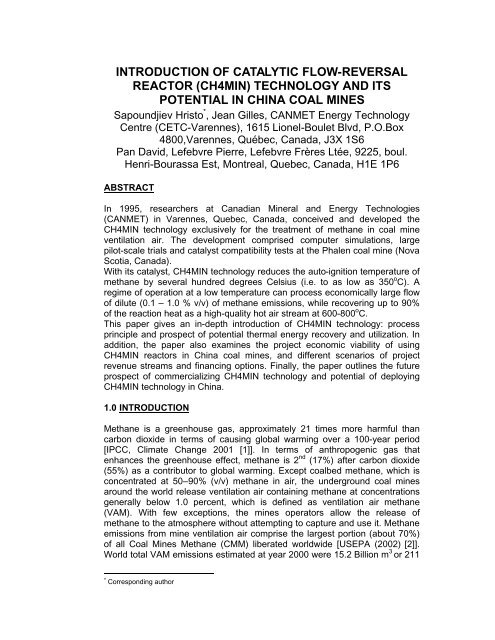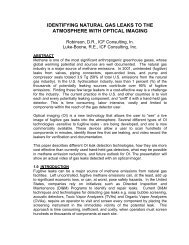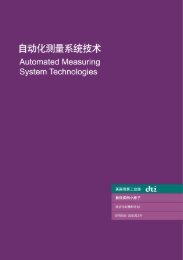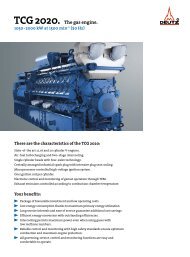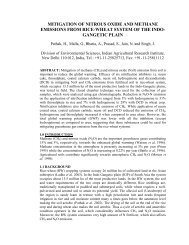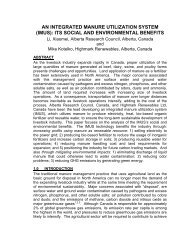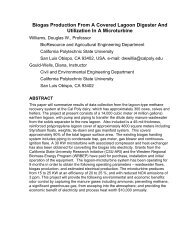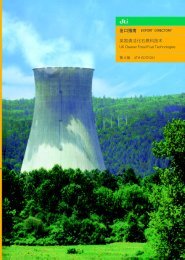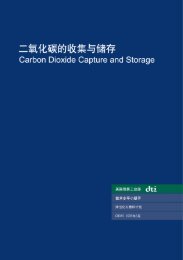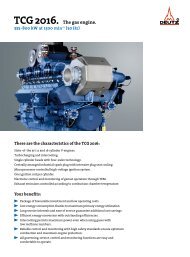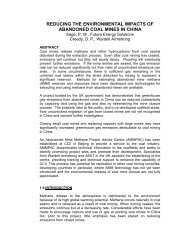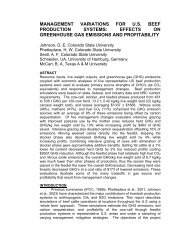introduction of catalytic flow-reversal reactor (ch4min) technology ...
introduction of catalytic flow-reversal reactor (ch4min) technology ...
introduction of catalytic flow-reversal reactor (ch4min) technology ...
Create successful ePaper yourself
Turn your PDF publications into a flip-book with our unique Google optimized e-Paper software.
INTRODUCTION OF CATALYTIC FLOW-REVERSAL<br />
REACTOR (CH4MIN) TECHNOLOGY AND ITS<br />
POTENTIAL IN CHINA COAL MINES<br />
Sapoundjiev Hristo * , Jean Gilles, CANMET Energy Technology<br />
Centre (CETC-Varennes), 1615 Lionel-Boulet Blvd, P.O.Box<br />
4800,Varennes, Québec, Canada, J3X 1S6<br />
Pan David, Lefebvre Pierre, Lefebvre Frères Ltée, 9225, boul.<br />
Henri-Bourassa Est, Montreal, Quebec, Canada, H1E 1P6<br />
ABSTRACT<br />
In 1995, researchers at Canadian Mineral and Energy Technologies<br />
(CANMET) in Varennes, Quebec, Canada, conceived and developed the<br />
CH4MIN <strong>technology</strong> exclusively for the treatment <strong>of</strong> methane in coal mine<br />
ventilation air. The development comprised computer simulations, large<br />
pilot-scale trials and catalyst compatibility tests at the Phalen coal mine (Nova<br />
Scotia, Canada).<br />
With its catalyst, CH4MIN <strong>technology</strong> reduces the auto-ignition temperature <strong>of</strong><br />
methane by several hundred degrees Celsius (i.e. to as low as 350 o C). A<br />
regime <strong>of</strong> operation at a low temperature can process economically large <strong>flow</strong><br />
<strong>of</strong> dilute (0.1 – 1.0 % v/v) <strong>of</strong> methane emissions, while recovering up to 90%<br />
<strong>of</strong> the reaction heat as a high-quality hot air stream at 600-800 o C.<br />
This paper gives an in-depth <strong>introduction</strong> <strong>of</strong> CH4MIN <strong>technology</strong>: process<br />
principle and prospect <strong>of</strong> potential thermal energy recovery and utilization. In<br />
addition, the paper also examines the project economic viability <strong>of</strong> using<br />
CH4MIN <strong>reactor</strong>s in China coal mines, and different scenarios <strong>of</strong> project<br />
revenue streams and financing options. Finally, the paper outlines the future<br />
prospect <strong>of</strong> commercializing CH4MIN <strong>technology</strong> and potential <strong>of</strong> deploying<br />
CH4MIN <strong>technology</strong> in China.<br />
1.0 INTRODUCTION<br />
Methane is a greenhouse gas, approximately 21 times more harmful than<br />
carbon dioxide in terms <strong>of</strong> causing global warming over a 100-year period<br />
[IPCC, Climate Change 2001 [1]]. In terms <strong>of</strong> anthropogenic gas that<br />
enhances the greenhouse effect, methane is 2 nd (17%) after carbon dioxide<br />
(55%) as a contributor to global warming. Except coalbed methane, which is<br />
concentrated at 50–90% (v/v) methane in air, the underground coal mines<br />
around the world release ventilation air containing methane at concentrations<br />
generally below 1.0 percent, which is defined as ventilation air methane<br />
(VAM). With few exceptions, the mines operators allow the release <strong>of</strong><br />
methane to the atmosphere without attempting to capture and use it. Methane<br />
emissions from mine ventilation air comprise the largest portion (about 70%)<br />
<strong>of</strong> all Coal Mines Methane (CMM) liberated worldwide [USEPA (2002) [2]].<br />
World total VAM emissions estimated at year 2000 were 15.2 Billion m 3 or 211<br />
* Corresponding author
Mt equiv. CO 2 /y (Million metric tons <strong>of</strong> equivalent CO 2 per year) [USEPA (2002a)<br />
[3]]. In light <strong>of</strong> ever-increasing pressure for reducing GHG emissions and<br />
meeting the reduction targets set in the Kyoto Protocol, reducing VAM<br />
emissions is becoming a very important task in the 21st century.<br />
The CH4MIN <strong>technology</strong> was developed exclusively for use on treatment <strong>of</strong><br />
methane in coal mine ventilation air. With its catalyst, the CH4MIN <strong>technology</strong><br />
reduces the auto-ignition temperature <strong>of</strong> methane by several hundred degrees<br />
Celsius (i.e. to as low as 350°C). It provides a great potential for the use <strong>of</strong><br />
VAM as a principal fuel source because the <strong>technology</strong> is able to oxidize<br />
diluted methane in coal mine ventilation air and produce useable energy from<br />
heat exchangers operating at an optimal temperature. Consequently, the new<br />
<strong>technology</strong> not only provides a feasible solution to eliminate methane in<br />
ventilation air, but also could generate value through recovered energy (hot<br />
air, water and steam) during the process.<br />
2.0 CH4MIN OPERATING PRINCIPLES<br />
The schematic <strong>of</strong> a typical CH4MIN process is shown in Figure 1. It consists<br />
<strong>of</strong> a <strong>reactor</strong>, two pairs <strong>of</strong> valves and a heat removal system in the central<br />
region separating the catalyst bed in two parts. At both ends <strong>of</strong> the <strong>reactor</strong>, an<br />
inert material bed is present and acts as a thermal accumulator. Flow <strong>reversal</strong><br />
is controlled by the two sets <strong>of</strong> valves. During the first half-cycle, the methaneair<br />
mixture, which is originally at ambient temperature, is heated as it passes<br />
through the upper inert bed. It enters the upper catalyst bed at a temperature<br />
sufficient for exothermic methane oxidation to occur, which produces heat in<br />
the <strong>reactor</strong>. The stream then passes through the lower catalyst bed and finally<br />
heats the lower inert bed before exiting to atmosphere. During this first halfcycle,<br />
the upper part <strong>of</strong> the <strong>reactor</strong>, which was initially hot, cools down, while<br />
the lower part, which was initially cool, heats up. After a certain period <strong>of</strong> time,<br />
the <strong>flow</strong> direction is reversed by inverting the position <strong>of</strong> the valves in order to<br />
use the heat available in the lower inert bed. At the end <strong>of</strong> the second halfcycle,<br />
downward <strong>flow</strong> is re-established. The heat generated in excess by the<br />
exothermic chemical reaction is withdrawn by the heat removal system in the<br />
mid-section <strong>of</strong> the <strong>reactor</strong>.<br />
3.0 NUMERICAL SIMULATION AND EXPERIMENTATION<br />
A mathematical model and computer programs were developed for the study<br />
and design <strong>of</strong> CH4MIN <strong>reactor</strong>s. A transient two-dimensional heterogeneous<br />
model is combined with a numerical method allowing the fast formulation <strong>of</strong><br />
new <strong>reactor</strong> designs, [Aube and Sapoundjiev, 2000, [ 4 ] ] . The program has<br />
been validated with experiments performed with a 500-mm <strong>reactor</strong>. The<br />
comparisons between the experimental data (circles) and predictions by the<br />
model (lines) are shown in Figure 2(a-d). Good agreement with the<br />
experiments was observed. The dynamic behaviour <strong>of</strong> the CH4MIN can be<br />
predicted accurately by the model for a wide range <strong>of</strong> conditions including<br />
small <strong>reactor</strong> diameter and low air <strong>flow</strong> rate.
Temperature °C<br />
800<br />
600<br />
400<br />
200<br />
2<br />
INERT PACKING<br />
1<br />
CATALYST<br />
Heat<br />
Exchanger<br />
Mine Ventilation<br />
Air<br />
CATALYST<br />
Discharge to<br />
Atmosphere<br />
1<br />
INERT PACKING<br />
2<br />
Figure 1. Flow diagram <strong>of</strong> the CH4MIN <strong>technology</strong><br />
TEMPERATURE (C)<br />
800<br />
700<br />
600<br />
500<br />
400<br />
300<br />
200<br />
100<br />
0<br />
0 0.1 0.2 0.3 0.4 0.5 0.6 0.7 0.8 0.9 1<br />
REACTOR LENGTH<br />
Fig. 2 (a):<br />
800<br />
700<br />
hot air<br />
withdrawal<br />
beginning (---) and end<br />
(o,⎯) <strong>of</strong> the first semicycle.<br />
TEMPERATURE (C)<br />
800<br />
700<br />
600<br />
500<br />
400<br />
300<br />
200<br />
100<br />
0<br />
0 0.1 0.2 0.3 0.4 0.5 0.6 0.7 0.8 0.9 1<br />
REACTOR LENGTH<br />
Fig. 2 (b):<br />
800<br />
700<br />
hot air<br />
withdrawal<br />
beginning (---,•) and<br />
end (o,⎯) <strong>of</strong> the<br />
second semi-cycle.<br />
TEMPERATURE (C)<br />
600<br />
500<br />
400<br />
300<br />
200<br />
100<br />
0<br />
0 0.1 0.2 0.3 0.4 0.5 0.6 0.7 0.8 0.9 1<br />
REACTOR LENGTH<br />
Fig. 2 (c):<br />
temperature pr<strong>of</strong>ile<br />
along the <strong>reactor</strong><br />
length after 10 cycles.<br />
TEMPERATURE (C)<br />
600<br />
500<br />
400<br />
300<br />
200<br />
100<br />
0<br />
0 0.1 0.2 0.3 0.4 0.5 0.6 0.7 0.8 0.9 1<br />
REACTOR LENGTH<br />
Fig. 2 (d):<br />
temperature pr<strong>of</strong>ile<br />
along the <strong>reactor</strong><br />
length after 15 cycles.<br />
Figure: 2 (a-d) Temperature pr<strong>of</strong>iles along the <strong>reactor</strong> length and time<br />
evolution <strong>of</strong> the temperature distribution in the <strong>reactor</strong>. Experimental results<br />
(circles) and prediction by the model (lines). Methane concentration 0.3 v/v %.
4.0 HEAT RECOVERY EFFICIENCY AND BENEFITS<br />
The heat recovery efficiency <strong>of</strong> the CH4MIN <strong>technology</strong>, based on<br />
experimental results is illustrated in Figure 3 as a function <strong>of</strong> methane<br />
concentration. Results show that the <strong>reactor</strong> operates in autothermal regime<br />
(with no need for external heat) even when the methane concentration is as<br />
low as 0.1% v/v. Significant heat recovery is possible at higher concentrations.<br />
For concentrations between 0.3 and 1.0% v/v <strong>of</strong> methane, the heat recovery<br />
efficiency <strong>of</strong> the CH4MIN <strong>technology</strong> is between 50 and 95%. For a typical<br />
coal mine concentration, 0.5% v/v <strong>of</strong> methane, the efficiency is 75%.<br />
The benefits <strong>of</strong> CH4MIN <strong>technology</strong> are shown on base <strong>of</strong> single mine. The<br />
calculations were performed using a <strong>flow</strong> rate <strong>of</strong> 100 m 3 /s <strong>of</strong> coal mine<br />
ventilation air at 0.5% v/v <strong>of</strong> methane. In the current situation, mine ventilation<br />
air is rejected to the atmosphere. The greenhouse gas emissions are<br />
equivalent to 238 kilotones <strong>of</strong> CO 2 per year. Gases rejected to the atmosphere<br />
contain a large amount (17.9 MW or 560 GJ/y) <strong>of</strong> potential thermal energy,<br />
which is not utilized. The proposed treatment <strong>of</strong> this mine ventilation air with<br />
the CH4MIN <strong>technology</strong> provides the following benefits: heat recovery: 14<br />
MW therm. or 425 000 GJ therm / year and reduced greenhouse gas emissions:<br />
208 kilotons equivalent CO 2 /year.<br />
Extracted heat / Total heat produced by reaction (%)<br />
100<br />
80<br />
60<br />
40<br />
20<br />
0<br />
0.0 0.2 0.4 0.6 0.8 1.0<br />
Methane concentration in coal mine air (v/v%)<br />
Figure 3. Efficiency <strong>of</strong> the extracted heat as a function <strong>of</strong> methane<br />
concentration.
5.0 ECONOMICS<br />
A preliminary economic assessment has been performed to estimate the<br />
value <strong>of</strong> the thermal heat produced by the CH4MIN <strong>technology</strong>, as applied to<br />
the treatment <strong>of</strong> underground coal mine ventilation air. The results are shown<br />
in Table 1.The main conclusions are:<br />
The cost <strong>of</strong> producing 1 GJ <strong>of</strong> thermal energy with the CH4MIN <strong>technology</strong> is<br />
US$ 1.97. When the environmental effect is taken into account with basic CO 2<br />
credit rate <strong>of</strong> US$ 1.5 per tonne <strong>of</strong> avoided CO 2 emissions (Canter Fitzerald,<br />
2001), the net unit cost to produce 1 GJ <strong>of</strong> energy is decreased to US$ 1.15.<br />
The CO 2 credit value leading to a cost-revenue break-even point, for various<br />
energy prices is shown in Figure 4. A simple model was used, where<br />
revenues cover operating and financing costs (capital and interest) over a 15-<br />
year period. The following assumptions were made: the CH4MIN unit treats<br />
100 cubic meters per second <strong>of</strong> ventilation air; the total cost <strong>of</strong> the unit is 3.5<br />
million US$ (including installation) and is financed entirely at 10%, over a 15-<br />
year period; the inflation rate is 2%. The results show that the CH4MIN<br />
<strong>technology</strong> becomes economically viable even if it is used only for methane<br />
destruction, when the CO 2 credits are over US$ 6.0 per tonne.<br />
Table 1: Economic assessment <strong>of</strong> the CH4MIN <strong>technology</strong><br />
Basic assumptions:<br />
Ventilation air <strong>flow</strong> rate<br />
100 m 3 /sec.<br />
Methane concentration in air<br />
0.5 % v/v<br />
Methane heating value<br />
36 MJ/m 3<br />
Energy recovery efficiency<br />
75 %<br />
Life expectancy <strong>of</strong> the <strong>reactor</strong><br />
15 years<br />
Catalyst replacement interval<br />
4 years<br />
Utilization factor<br />
95 %<br />
Ratio <strong>of</strong> GWP CH 4 /CO 2<br />
21<br />
Currency<br />
US Dollars<br />
Net recovered energy by CH4MIN<br />
Greenhouse gas reduction:<br />
Amount <strong>of</strong> methane oxidized CO 2<br />
equivalent<br />
Costs:<br />
Capital costs<br />
(<strong>reactor</strong>; blower; construction costs;<br />
engineering)<br />
Operating costs over 15 years<br />
(catalyst; operation and maintenance;<br />
electricity for fan operation)<br />
Total costs (capital and operating)<br />
Unit costs:<br />
Energy value (over 15 years)<br />
CO 2 value (CO 2 credit rate: $1.50/tonne<br />
Net unit cost<br />
405 000 GJ/Year<br />
10 700 tonnes/year<br />
208 000 tonnes/year<br />
3.5 M$<br />
4.4 M$<br />
7.9 M$<br />
1.97 $/GJ<br />
0.82 $/GJ<br />
1.15 $/GJ
CO2 credits ($/tonne)<br />
10<br />
8<br />
6<br />
4<br />
2<br />
0<br />
0 0,2 0,4 0,6 0,8<br />
Methane concentration (% v/v)<br />
0 $ / GJ<br />
1 $ / GJ<br />
2 $ / GJ<br />
Figure 4. CO 2 credit value leading to cost-revenue break-even point for<br />
various energy selling prices<br />
6.0 NEXT STEPS<br />
Since the beginning <strong>of</strong> 2003, Lefebvre Frères Ltée, a Canadian equipment<br />
manufacturer based in Montréal, has begun to work on commercializing the<br />
CH4MIN <strong>technology</strong><br />
The commercialization plan is to build a demo CH4MIN <strong>reactor</strong>, which could<br />
process about 5.0 m 3 /s ventilation air methane <strong>flow</strong>, and conduct field testing<br />
in a China coal mine. In addition, various thermal energy extraction and<br />
utilization applications, including co-generation by gas or steam turbines, will<br />
be developed by CETC-Varennes and Lefebvre Frères Ltée.<br />
Lefebvre and CETC-Varennes will verify the design parameters, engineering<br />
and various operation issues during the demonstration process. Lefebvre<br />
plans to put the demonstration project in a Sino-Canadian Clean Development<br />
Mechanism (CDM) in order to prepare for future carbon credits trading related<br />
to CH4MIN <strong>reactor</strong>s.<br />
After the demo process the next step is a full scale CH4MIN <strong>reactor</strong> and a cogeneration<br />
plant in a China coal mine. Each full scale CH4MIN <strong>reactor</strong> will<br />
oxidize methane equivalent to 117,500 tons CO 2 per year and recover 7 MW<br />
thermal energy, including 2 MW electricity through a co-generation plant.<br />
At present, Lefebvre and CETC-Varennes are discussing with the other<br />
partners in Canada and abroad to finalize the <strong>technology</strong> transfer.
7.0 CONCLUSION<br />
The development <strong>of</strong> the CH4MIN <strong>technology</strong> and its application on elimination<br />
<strong>of</strong> dilute methane emissions, along with heat recovery, has been shown to be<br />
a technically and economically viable solution to a major global warming<br />
problem. The <strong>technology</strong> has significant and multiple impacts on greenhouse<br />
gas reduction. First, it produces thermal energy using mine ventilation air<br />
containing dilute methane (0.1-1.0% v/v), which was previously emitted to<br />
atmosphere. Every 100 m 3 / s <strong>of</strong> mine ventilation air (0.5% v/v <strong>of</strong> methane)<br />
treated with the CH4MIN <strong>technology</strong> reduces greenhouse gas emissions by<br />
208 kilotons equivalent CO 2 /year. Second, it converts the dilute methane gas<br />
at a temperature below 850 o C, and the exhaust gases contain no NO x ,<br />
another important greenhouse gas. Using the CH4MIN <strong>technology</strong> as an<br />
external heat source for a gas turbine is beneficial to the turbine operation<br />
since no NO x is produced. Third, the thermal energy produced is<br />
environmentally friendly. The same amount <strong>of</strong> energy produced by other<br />
technologies, using coal or liquid fuels would additionally pollute the<br />
atmosphere with NO x and SO x gases. The recovered heat can be used near<br />
the mine site or be converted to electrical power, which can then be<br />
transmitted to user sites.<br />
With increasing energy need and coal mining activity, China has vast<br />
resources in ventilation air methane with large average shaft ventilation air<strong>flow</strong><br />
and high concentration. Apply CH4MIN <strong>technology</strong> in China coal mines will<br />
not only eliminate methane emission, but also bring useable clean thermal<br />
energy to local market as well as generate considerable carbon credits<br />
through CDM with developed countries. In addition, it would be a great<br />
interest for local manufacturing industry to produce CH4MIN <strong>reactor</strong>s in China<br />
through licensing or <strong>technology</strong> transfer in future.<br />
8.0 REFERENCES<br />
1. IPCC (2001), Climate Change 2001: The scientific Bases,<br />
Intergovernmental Panel on Climate Change, Cambridge University<br />
Press, New York, New York.<br />
2. USEPA (2002) report 430-R-03-002, Assessment <strong>of</strong> the Worldwide<br />
Market Potential for Oxidizing Coal Mine Ventilation Air Methane, July<br />
2003.<br />
3. US Inventory Changes, USEPA, January 2002.<br />
4. Aube F., Sapoundjiev H., 2000, Computers & Chemical Engineering,<br />
24, 2623-2632.


